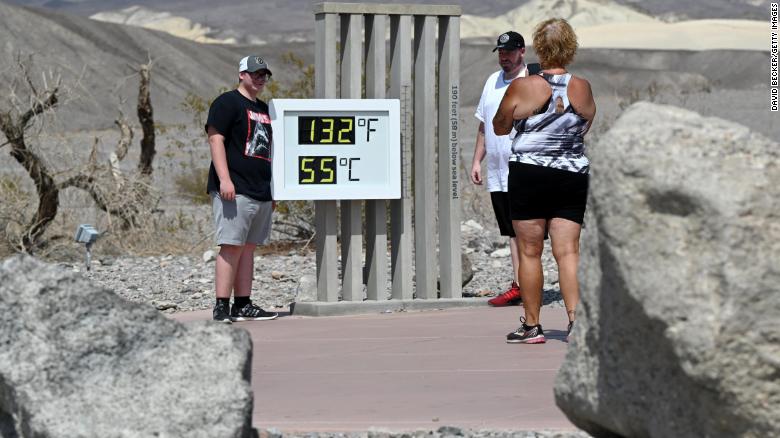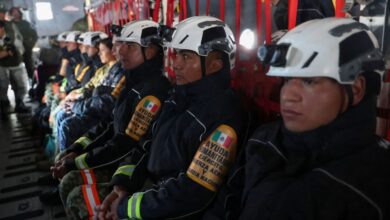
(CNN) – Heat waves are the deadliest weather disaster in the US. They account for nearly 150 fatalities per year, more than hurricanes and tornadoes combined.
New legislation in California hopes to reduce heat-related deaths by ranking heat waves similarly to hurricanes, by using categories and names. However, the National Weather Service (NWS) is currently in a multiyear experiment to also categorize heat waves.
“Globally, people are suffering from heat because of a deadly awareness gap,” said Kurt Shickman, the director of Extreme Heat Initiatives at the Adrienne Arsht-Rockefeller Foundation Resilience Center (Arsht-Rock), which is helping lead the legislative action.
“On one hand, there is still a low level of awareness of the risks of heat illness and death. People simply don’t think of themselves as vulnerable. And on the other hand, heat quietly kills about half a million people per year globally, making it the deadliest natural disaster we face.”
Both the NWS and the groups behind the new measures are working to fix the deadly awareness gap.
Legislation to save lives
The new legislation proposed in California is in the form of two separate bills with one goal, to create a statewide heat ranking system, similar to the Saffir-Simpson scale used for hurricanes, to better prepare the public.
“Assembly Bill 2238 is tightly focused on preparing and safeguarding people from heat,” Shickman said. “Assembly Bill 2076 covers a broad set of heat efforts that will result in better heat resilience and mitigation.”
The bills would establish a Chief Heat Officer role, create an interagency heat task force and an extreme heat advisory council.
Shickman added there have also been discussions about naming heat waves.
“Putting a name to a heat wave is [supported] by studies on human behavior, psychology, and finding the right trigger to spur action to prepare for an extreme heat event,” Shickman noted.
Naming extreme temperature events could begin as early as this summer.
“Athens, Greece and Seville, Spain, are the first two cities globally to pilot heat wave naming and categorization beginning on May 1, 2022,” Shickman pointed out. Arsht-Rock fully anticipates other cities, including those in the US, to similarly follow suit in the coming years.
The bill also wants to categorize the heat waves into a simple numerical system.
“For example, people and authorities prepare and take action very differently when facing an imminent Category 1 versus a Category 5 hurricane,” Shickman explained. “This bill would give us the same capacity to encourage safer citizens in a similar way when facing heat.”
He argued there is merit to the effort because social scientists have noted humans tend to do better at deciphering simple messages rather than complex ones containing too many words.
“It’s important to make information easily accessible, easily digestible, and actionable,” said Makenzie Krocak, a research scientist for the University of Oklahoma Institute for Public Policy Research and Analysis. “People are much more consistent about interpreting numbers. That doesn’t necessarily mean that they are more likely to respond, but it does mean that interpretation is more consistent from person to person.”
However, the new categories and names would not necessarily come directly from the NWS, as weather information usually does.
Instead, the legislation charges California’s EPA for the naming and categorizing of the heat waves, but the NWS would provide the raw weather data to the EPA and would be the conduit for any of their warnings or messaging.
“We’ve made a great effort to design and pilot a categorization process for heat events that would work smoothly with the NWS process,” Shickman said. “We see categorization and the inclusion of human health outcomes as enhancements to a good warning system, not a replacement for it.”
Though Shickman also pointed out, “We are not currently working with the National Weather Service, but would very much like to collaborate in the future.”
A similar system is currently in place
The NWS has its own experimental “HeatRisk tool” currently in place.
The tool provides a quick view of heat risk potential over the upcoming seven days, categorizing the heat both numerically (0-4) and with a color (green/yellow/orange/red/magenta), along with identifying groups potentially most at risk at each level.
“Using this HeatRisk tool, we are able to move away from hard temperature thresholds and toward societal impacts when making decisions surrounding heat advisories, watches, and warnings.” meteorologist Jenn Varian at the NWS office in Las Vegas said.
Similarly, Shickman noted one of the main goals of the legislation is to “establish categories for heat waves, based on how dangerous they are estimated to be for human health.”
The NWS developed the HeatRisk program in order to better assess the risks and allow people to prepare for upcoming heat events.
“We developed these categories based on climatology, but also based on collaborative work we’ve done with the CDC [Centers for Disease Control and Prevention],” said Paul Iñiguez, a Science and Operations Officer at the NWS office in Phoenix.
Through collaboration, they were able to determine the yearly death toll caused by heat stroke and heat exhaustion.
“From there we were able to determine threshold temperatures of when you start to see impacts, the worse impacts from the heat, and that is how we determined our yellow level threshold,” Iñiguez explained.
Iñiguez and his colleagues surveyed several hundred locations across the country, then mapped the results to show the varied thresholds across the entire country.
“Just last year in Maricopa County, where Phoenix is located, there were 330 heat-related deaths,” Iñiguez pointed out. “And as we know with climate change, locations are warming up. Phoenix and the Southwest are showing a drastic increase in temperature trends.”




